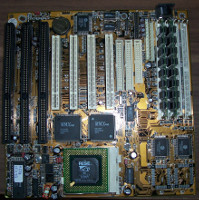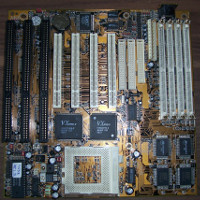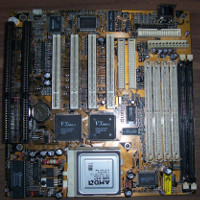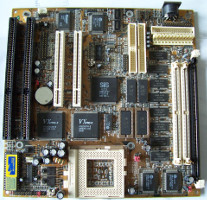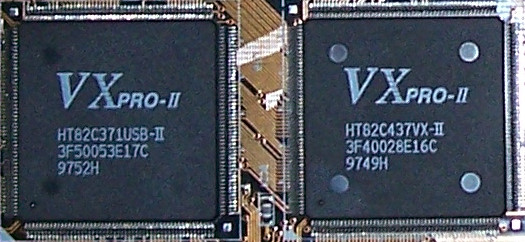
What I found about this exotic socket 7 chipset...
- Sold by Taiwanese company UTron (was mainly a SRAM manufacturer) with the bios name "UT801x".
- The official datasheet name was UT85C501 / UT85C502.
- The manufacturer ID on the PCI bus is: "PLX Technology (was HiNT Corp.)"
- The chipset was relabeled by PcChips as "MMXPro" or "VXPro-II".
- It was mounted on the low budget PcChips boards: M558, M559 and M592.
- I found only one additional board which uses this chipset: PT-PRO7 from Pretech.
- Sometimes the VXPro-II is confused with the VXPro chipset. But this is completely different part: behind VXPro hides a relabeled VIA VT82C580VPX.
The UT85C501 has some disadvantages:
- No (Ultra) DMA-modus for the IDE drivers (PIO-mode 4 is the fastest setting) which gave the chipset a very bad reputation.
- No SDRAM support, only FPM or EDO RAM modules (also for the 168 pins socket(s) on the M559 and M592)
- The M592 supports at least 3.3V 168 pins EDO RAM modules
- It is not possible to use a single PS/2 RAM module, you always need two pieces.
- USB1.0 port doesn't fit the final USB1.0 standard and has so no enable function in the bios.
A further weak point is: NetBSD and older Linux versions (kernel 2.4) have no PCI-bridge driver for this chipset. With exception of a VGA card you can't use any other PCI-slots (no PCI devices are found).
OpenBSD and newer Linux versions (tested with Slackware 14.2) have no problems.
Some additional stuff:
- The above mentioned board Pretech PT-PRO7 seems to use a UT85C503 chip with Ultra-DMA33. Until now I have only found this small entry about this chip.
- According to the PCI-ID: HiNT was a manufacturer of the (quite good) 486 chipset CS8005. Later they made industrial PCI-to-PCI bridges but I don't know how came the chipset division to UTron?
- UTron showed 1998 on the Computex in Taipei the 100MHz chipset UT85C511 / UT85C512 with integrated TAG-RAM and Ultra-DMA33 in two PQFP208 housings.
- End of 1998 UTron presented at the COMDEX the UT85C512, a single chip solution for socket 7 boards with integrated 512kB cache and clock generator in a 533 pins BGA housing.
- So far, I haven't found out if these chips have ever gone into mass production. If you know anything about it, please tell me... :o)
PcChips M558, M559 and M592
The three motherboards are very similar.
I own two versions of M558. On the first one the chipset is labeled as
"MMXPRO" (produced end of 1997). The second one is marked as revision 3.0 (produced begin of 1998) with the more common
chipset label VXPRO-II:
The M559 has a CMI8330A ISA sound chip on board (was relabeled by PcChips as HT1869V+), 512kB single chip cache and two additional DIMM sockets (for 5V modules only):
M592 has also CMI8330A ISA sound plus SiS6215 graphic chip (1MB Video-RAM, optional 2MB) on board, only two PS/2 SIMM sockets (but with 16MB RAM already mounted on the board) and one 168 pins DIMM socket for 3.3 or 5V FPM / EDO modules:
Benchmark in comparison to PcChips M537 and PcChips M558
The M537 is the "sister" board of the M558 but it uses the VIA VT82C580VPX with USB1, Ultra-DMA33 and 3.3V SDRAM support. Both boards were produced nearly at the same time (end of 1997) so they are well suited for comparison. I used an AMD K6-233 processor (clocked with 66MHz x 3) which is a suitable processor (date code 1997) for both motherboards... The exact setup is documented in this LibreOffice spread sheet. If you startup both motherboards the M537 feels much faster than the M558...
First we tested the IDE-interface. The result here should be clear because of the missing Ultra-DMA mode in the UTron chipset. It achieves only one third of the performance of the VIA chipset during the write test and a half of the performance during the read test:

But also the cache / memory interface was not state of the art:
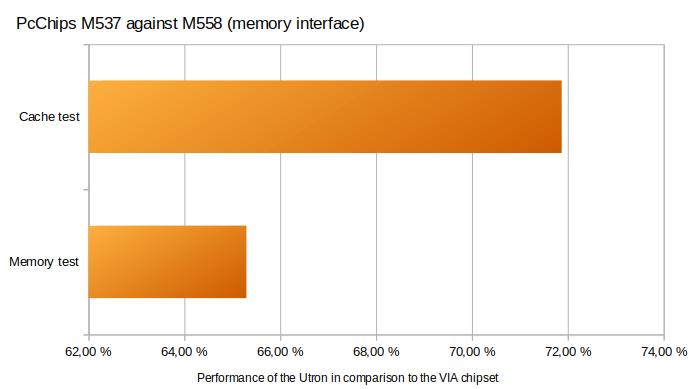
Now we understand the bad reputation of the VXPro-II chipset boards. They have only one more thing left: the most exotic chipset of all socket 7 boards... :o)
A little bit tuning on M558
My M558 boards were only equipped with 256kB cache and 8kB tag-RAM. 64MB RAM can be cached with this size but the maximum capability of the M558 is 128MB.
Two additional cache chips can be mounted on the motherboard but this is only a task for advanced electronic hobbyists:
- Remove the old tag-RAM chip, which was a UTron UT6164JC-15 (8KBytes x 8) in my case. It is much easier if you temporarily remove the electrolytic capacitor which is place between tag-RAM and edge of the board.
- Place a tag-RAM with 32kBytes x 8 and 5V power supply in a SOJ28 package. I used an ISSI IS61C256AH-12J here which still was available on ebay in 2019.
- If you have a wired jumper as cache size selector: removed it and place a three pins jumper instead.
- Place two additional cache chips: you need 32kBytes x 32 chips with 3.3V power supply in a 100 pins QFP package. I used here ISSI again: IS61C632A-7TQ (bought also on ebay).
Now we have 512kBytes cache for 128MB RAM:
falk.richter*at*yandex.com
Last update: February 17, 2020
